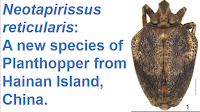Pond Skaters, Gerridae, are Hemipterans (True Bugs) able to skate upon the surface of water using a combination of surface tension and hydrophobic hairs on their legs. This has enabled them to colonise ponds, rivers, lakes and marine environments. Surprisingly, despite being nearly ubiquitous in environments with excellent potential for fossil preservation, and having a history which stretches back to the Mesozoic, fossil Pond Skaters are surprisingly rare.
In a paper published in the European Journal of Taxonomy on 15 August 2023, André Nel of the Institut de Systématique, Évolution, Biodiversité at Sorbonne Université, Bastien Mennecart of the Natural History Museum Basel, Tamara Spasojevic and Alexandra Viertler, also of the Natural History Museum Basel, and of the Institute of Ecology and Evolution at the University of Bern, Olivier Maridet of the Jurassica Museum, and the Department of Geosciences at the University of Fribourg, Loïc Costeur, again of the Natural History Museum Basel, Romain Garrouste, also of the Institut de Systématique, Évolution, Biodiversité at Sorbonne Université, and Pauline Coster of the Réserve Naturelle Nationale Géologique du Luberon, describe a new species of Pond Skater from the Oligocene Murs Palaeolake, which is part of the Luberon system of Palaeolakes in southern France.
The Murs Palaeolake formed in the Murs Graben, or Basin of Sénanque-Murs, between Apt and Carpentras in the Vaucluse Department of France. The lake deposits are of Eocene-Oligocene age, and overlie Cretaceous marine sediments. Les Vergiers is a locality within the Réserve Naturelle Nationale Géologique du Luberon with an exposed 20-30 cm sequence of Rupelian (Early Oligocene) Sables et grès verts de la Valette-de-Pernes (a sequence of grey marls with limestone inclusions which is up to four metres thick in other areas and has produced numerous terrestrial Vertebrate fossils) is overlain by a three metre thick section of the Laminites à Poissons de Murs, a sequence of laminated limestones and marls, considered to be of Middle Oligocene age, which is in turn overlaid by the massive green sandstone of the Marnes et grès verts de Murs.
The Laminites à Poissons de Murs seqience at Les Vergiers is highly fossiliferous, and was heavily exploited by amateur and commercial fossil collectors until the creation of the Réserve Naturelle Nationale Géologique du Luberon in 1987, with excavations since that time needing prior authorization from the reserve authorities. The most abundant fossils from the Laminites à Poissons de Murs are Fish, predominantly Dapalis macrurus, as well as some Plant fossils. Recent excavations at Les Vergiers, carried out in 2021-2022 have yeilded a number of small Fish assigned to Prolebias sp., some Plant remains, some Gastropods, some possible freshwater Jellyfish, and some Insects.
One of these Inesects is a Pond Skater, which Nel et al. name Oligoptilomera luberonensis, where 'Oligoptilomera' is a combination of 'Oligocene' and the modern Pond Skater genus name 'Ptilomera', and 'luberonensis' means 'from Luberon'. The new species is described from a single specimen, a wingless brown Pond Skater 9.3 mm long and 3.7 mm wide. This has white bands running along the lateral margins of its mesothorax, and three white spots on its head.
Oligoptilomera luberonensis appears to be a member of the Ptilomerinae, a group of Pond Skaters today restricted to Madagascar, China, Southeast Asia, and Papua New Guinea. While this seems surprising, an affinity between the Eocene and Oligocene faunas of Western Europe and that of modern East and Southeast Asia has been seen in multiple groups previously, and the presence of the group on Madagascar suggests that the Ptilomerinae were once much more widespread.
The Middle Oligocene Insect fauna at Les Vergiers appears to be similar to the Rupelian Insect fauna at the nearby laminated lacustrine limestones of Céreste. Fossil Insects are far more abundant at Céreste, but the Les Vergiers contains groups not known at Céreste, such as Pond Skaters and very large Weevils (Weevils are very common at Céreste, but are always small). The fauna and geology of the two site suggests that the palaeolake was probably much more shallow at Les Vergiers than at Céreste, probably close to a river system bringing in plant remains, while Céreste appears to represent a more open-water environment, possibly at the centre of a deep lake.
See also...
Online courses in Palaeontology.
Follow Sciency Thoughts on Facebook.
Follow Sciency Thoughts on Twitter.








